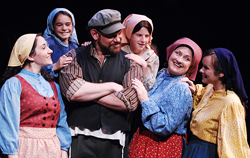By Donald H. Harrison


SAN DIEGO — For many Jews whose ancestors lived in Eastern Europe, Fiddler on the Roof provides a mythic context for understanding what their lives might have been like. Music from the show, such as “Sunrise, Sunset,” is routinely played at such simchas as bar mitzvah receptions and weddings. But what accounts for the musical’s popularity among Gentiles? What makes it so universally popular?
Those questions were put to Robert Smyth, producing artistic director of the Lamb’s Players Theater, which is offering the classic musical on its Coronado stage (1142 Orange Avenue) through July 14.
“I think like all really good stories, there is something in it that appeals to the whole human family,” he responded in a telephone interview. Audiences from different backgrounds (and non-Jewish performers too) may think “that is not my story directly but I certainly understand the sense of oppression and I understand trying to hold a family together.”
Symth said he finds “all sorts of really universal themes” in “Fiddler,” such as “the tension between tradition, which keeps the community together, and at the same time trying to follow your heart, with the choices of the daughters.”
Since joining Lamb’s Players Theater in 1976, the artistic director has directed over 100 plays including another “Fiddler” on a different stage in 1985.
Lamb’s Players Theater came into being at Bethel College in St. Paul, Minnesota, in 1971. Organized as a touring theater group, its principals moved to San Diego County in 1972, four years before Smyth joined the troupe. He was instrumental in converting the company from a traveling band of actors to an ensemble with a theater of its own. Today the company has two venues: the one in Coronado, and another in San Diego’s Gaslamp Quarter.
Smyth remembered that he was once asked “what is a Christian doing a Jewish play for?'”
He said his response was, “Wait a minute, the American musical belongs to all of us. For me, I have more affinity to the faith perspective that ‘Fiddler’ and the Jewish community come out of than to somebody in a secular, completely devoid of religious background or belief structure. The God that Tevye talks to is my God.”
“Fiddler,” he said, “carries a spiritual resonance, without being preachy, while being real — the same way that David’s Psalms are about real life, not just little religious tracts.”
When “Fiddler” is put on by professional theater companies (as opposed to children’s theaters), usually it is on a big stage, such as at San Diego’s Civic Theater, where Topol (who starred in the movie) wowed audiences in July 2009. Whereas the Civic Theater has nearly 3,000 seats, Lamb’s Theater in Coronado accommodates 350 patrons in a half-moon configuration, with seats rising from the stage in the style of an European amphitheater.
“We have seven rows in the theater; you are never more than seven rows away,” Smyth said. “There is no sight-line problem because it is a high rake, so no one’s head is in the way. You are looking down on the choreography. With so much theater you are looking up to it, so you don’t have a chance to see the intricate patterns and the work the choreographer does. It is all linear when you are looking straight at it. So that is a good thing. The intimacy is a good thing too for the actors. They are not just proclaiming something way to the back. There is a much more intimate take on the story.”
While some productions of “Fiddler” will utilize up to 60 actors, Lamb’s Players’ production has 30 in the cast and a band. “For ‘Fiddler’ that is not large, but for our stage it is large. We have different levels on the steps, and that way the choreography works.”
In assembling the cast, Smyth said he sought “triple threats” — people who could sing, dance and act — “so the persons with spoken roles, you are also going to see them doing the group choreography and the choral work.” Six of the cast members are members of Lamb’s repertory company, 13 are associate artists, and 13 will be performing with Lamb’s for the first time.
One of the bigest differences in this version of “Fiddler” will be the music, said Smyth. Instead of a Broadway style orchestra, the music will be performed by a 6-member klezmer band led by Mark Danisovzky that will be on stage and occasionally interacting with the cast. To prepare, various members of the band met with SDSU Prof. Yale Strom, the klezmer violinist who leads Hot P’STrom’i, and with Robert Zelickman, the UCSD professor who is also a clarinetist in the Second Avenue Klezmer Band.
In this production, Sam Zeller plays Tevye; Deborah Gilmour Smyth is Golde; Charlene Koepf, Tzeitel; Caitie Grady, Hodel; Megan Carmitchel, Chava; Brandon Joel Maier, Motel; Charles Evans, Perchik; Anton Fero, Fyedka; John Rosen, Lazar Wolf; and Ernest Saucedo, the Fiddler.
*
Harrison is editor of San Diego Jewish World. He may be contacted at donald.harrison@sdjewishworld.com